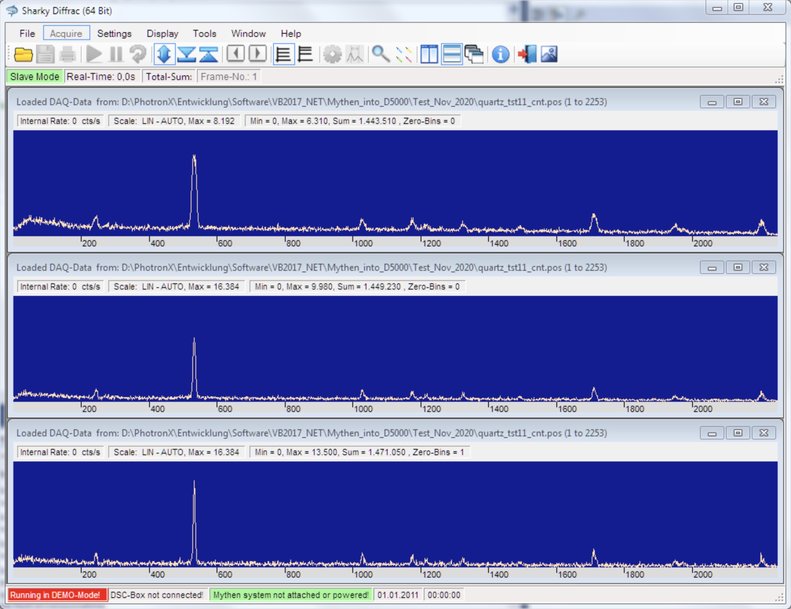www.electronics-usa.com
19
'21
Written on Modified on
DECTRIS News
Upgrade Powder X-ray Diffractometers with an Upgraded MYTHEN2
For Photron-X, making the hidden visible comes with a pragmatic approach to customers. This company specializes in servicing and upgrading all sorts of X-ray instruments and keeps the quality, cost, and time effort at the optimal level. There, an old powder X-ray diffractometer can get new life in only a couple of steps, and the results might be more than surprising! In this interview, Hannes Mio, the brain behind the company, describes how the increased frame rates of the upgraded MYTHEN2 R are used to perform a continuous scan in a D5000 Siemens X-ray diffractometer to optimize the measurement speed and quality of the collected data.

DECTRIS: What is the story behind Photron-X and MYTHEN2?
Hannes Mio, director of Photron-X: I have devoted the greatest part of my career to improving X-ray and neutron detection systems and their components. In 2005, I founded Photron-X with the mission, “value for money and high reliability”. We achieve this by efficient services and upgrades of X-ray instrumentation, such as old Siemens and Bruker D8 X-ray diffractometers. They have good mechanics and a robust geometry, so the software and detector upgrades can do wonders for them. The MYTHEN2 is a great fit for these X-ray diffractometers, and also for the company motto, because it offers high performance, but it is also robust, maintenance-free, and has a long warranty.
How and why is a MYTHEN2 detector integrated into an old Siemens or Bruker D8 detector?
Hannes: These diffractometers used to be delivered with a gas proportional counter detector. Compared to them, MYTHEN2 is more robust, requires no maintenance, has a higher dynamic range, and also has a higher frame rate. Keeping in mind that the diffractometers have good mechanics, it was possible to exploit the MYTHEN2 for both step and continuous scan, without causing vibrations in movements. In the step-scan mode, I could use the detector’s wide sensor to cover a wide angular range in a single shot. However, implementing the continuous scan required more work. One challenge was that Siemens and Bruker D8 powder X-ray diffractometers are designed in a Bragg-Brentano focusing geometry, so the use of a linear detector influences the line shape at the low 2θ angles. This is a known effect, and there was a solution at hand [1]. The other challenge was the frame rate of the original MYTHEN2: it was simply not sufficient for the task. The upgrade to 100 Hz resolved this, so I could proceed toward my goal.
How did you implement the continuous scan?
Hannes: This implementation heavily relied on collaboration with Dominik Kriegner. He and his colleagues have proposed an algorithm that adapts the range of the detector’s channels throughout the data collection [1]. In this approach, the detector’s small strip size was very beneficial. The number of “active” channels is increased as the detector goes from low to higher 2θ angles, so we call this approach an “adaptable window approach”. We used the MYTHEN2’s triggering feature to capture the continuous scan as a series of very small steps, where the rising signal is used to activate the detector and then perform the measurement for n milliseconds. That is, each rising signal starts a new data frame. The fastest movement corresponds to an exposure time of 10 ms.
We tested the adaptable window approach on a continuous scan using a D5000 Siemens diffractometer in the θ-θ geometry, with the fixed slits and a range from 2.5 to 160° in 2θ. However, the method also works for the θ-2θ geometry, as well as for instruments with variable slits. We were very happy to see the improvements in data collection and data quality.
What are the benefits of this type of continuous scan for the user?
Hannes: In general, the continuous scan enables users to increase the speed of the data collection, while the adaptable window approach allows them to improve peak shapes at low 2θ angles. As expected, we observed improvement in peak shapes and widths, but we also saw a lower background. This approach is implemented as a standard procedure, so that even an inexperienced user can run the adaptive window continuous scan without compromising data statistics. One additional benefit is that the process can be performed in a post-experiment setting. That is, the post-processing of data allows advanced users to define the level of resolution and statistics they need. The only thing the users need to decide in a pre-experiment setting is the exposure time.
The software for adaptable window in continuous scan is free of charge, and the source code is also available.
In the end, why should users upgrade their old powder X-ray diffractometer?
Hannes: Many of us know X-ray diffractometers, such as a Siemens D5000, which were abandoned for one reason or another: no service, an outdated detector, or non-supported software or firmware. It is a pity, because these X-ray diffractometers have good mechanics and good angular coverage: sometimes ranging from -100 to 160° in 2θ. Investing in expert hands and a fast detector with a wide sensor area can make such an X-ray diffractometer into a multipurpose machine: from measuring high-resolution PXRD data to conducting in situ experiments.

Influence of the adaptive window on a continuous scan: decreasing the number of used channels at low 2θ angles improves the peak shape and background.
Top: window size 128 bins; middle: 64 bins; bottom: 32 bins.
www.dectris.com

